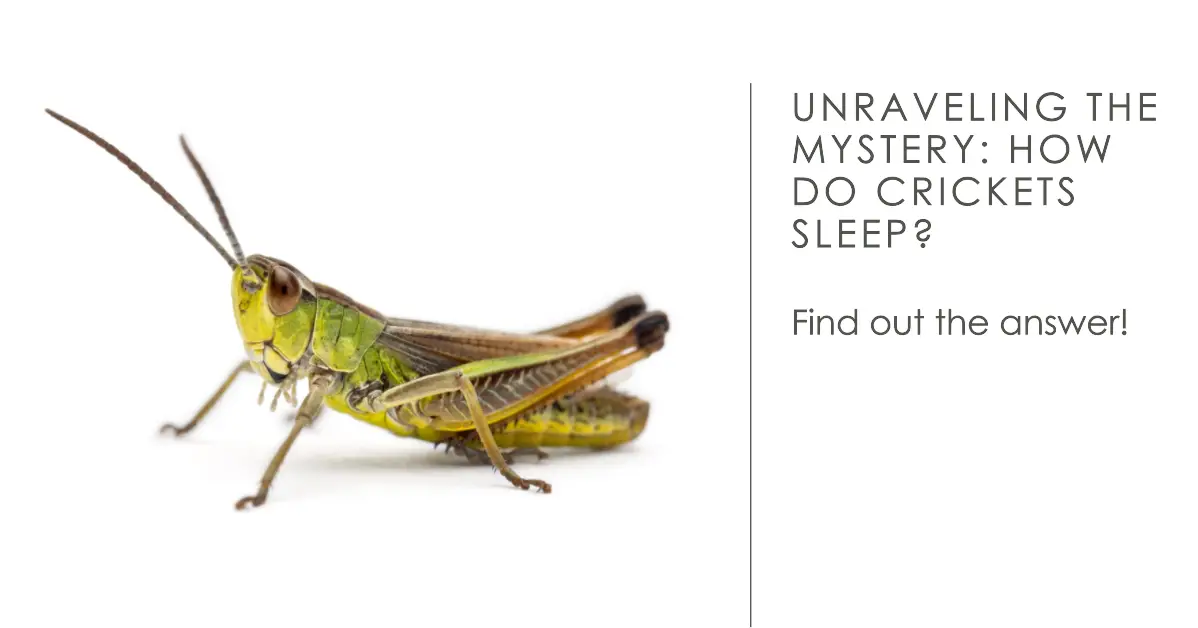
Jeffery Jago is a expert in horticulture and worm breeding. With a background in plant cultivation
Last Updated on March 26, 2023 by Jeffery Jago
Introduction
As the sun sets and the night sky takes over, you may have noticed the familiar sound of crickets chirping. These tiny creatures, often associated with warm summer nights, have intrigued many with their unique behaviors.
One aspect of cricket behavior that may pique your curiosity is how they sleep. In this article, we will delve into the world of cricket sleep patterns, how their biology plays a role in their resting habits, and the impact of human activity on their well-being.

Cricket Biology and Circadian Rhythms
Crickets are nocturnal insects, meaning they are most active during the night and tend to rest during daylight hours.
Like many other living organisms, crickets have a circadian rhythm – an internal biological clock that regulates their sleep and wake cycles.
This internal clock is primarily influenced by external factors, such as light and temperature.
When the temperature drops and the sun disappears, crickets become more active, searching for food and mates. Conversely, as the sun rises and the temperature increases, crickets tend to slow down and find shelter to rest.
The Sleeping Habits of Crickets
Although crickets don’t sleep like humans or other animals, they do exhibit periods of inactivity that serve as a form of rest.
During these periods, crickets remain motionless and silent, conserving their energy for the next bout of activity.
Cricket sleep patterns are different from human sleep patterns in several ways. While humans usually experience a single, continuous sleep period, crickets engage in multiple short rest periods throughout the day.
Additionally, crickets don’t exhibit rapid eye movement (REM) sleep like humans, so their rest may not be as deep as ours.
Factors such as the surrounding environment, disturbances, and the presence of predators can influence the sleep patterns of crickets. If they feel threatened or disturbed, crickets may become more alert and active, affecting their overall rest.
The Role of Sleep in Cricket Health and Survival
Rest is crucial for crickets, as it allows them to conserve energy and maintain their overall health. Adequate rest is vital for their survival and reproduction.
Crickets that don’t get enough rest may become more susceptible to predation, have shorter lifespans, and produce fewer offspring.
Sleep deprivation can have detrimental effects on crickets, just as it does in humans. Inadequate rest may lead to weakened immune systems, reduced ability to find food, and decreased reproductive success.
How Human Activity Affects Cricket Sleep
Human activities can have a significant impact on cricket sleep patterns. Artificial light, such as streetlights or porch lights, can disrupt crickets’ circadian rhythms and alter their behavior.
Exposure to artificial light may cause crickets to become more active during the day and less active at night, potentially affecting their ability to find food and mates.
Noise pollution is another factor that can disrupt cricket sleep patterns. Loud sounds, such as traffic or construction noise, can cause crickets to become more alert and active, reducing their overall rest.
To mitigate the impact of human activities on cricket populations, we can take measures such as reducing artificial light exposure and minimizing noise pollution, particularly in areas where crickets are known to reside.
Conclusion
Understanding how crickets sleep provides valuable insight into their fascinating behavior and highlights the importance of rest for these tiny creatures.
Recognizing the impact of human activities on cricket sleep patterns can also help inform ecological preservation and pest management efforts.
By appreciating the intricacies of cricket behavior, we can foster a greater sense of stewardship towards these fascinating insects and the environment they inhabit.
So, the next time you hear crickets chirping on a warm summer night, take a moment to ponder the complex world of cricket sleep and the delicate balance that exists between their rest and activity.
As we continue to study cricket behavior and sleep patterns, researchers may uncover new information that can further enhance our understanding of these remarkable insects.
This knowledge can contribute to the development of more effective and sustainable pest control methods, cultivation methods, as well as improved habitat conservation strategies.
It’s essential to remember that crickets, like all living creatures, play a vital role in the ecosystem and deserve our respect and attention.
In the meantime, take a moment to appreciate the symphony of cricket chirps that fill the night air. These tiny nocturnal musicians are not only the soundtrack to our summer evenings but also a reminder of the intricate natural world that surrounds us.
By learning more about crickets and their sleep habits, we deepen our connection to nature and gain a greater appreciation for the incredible diversity of life on our planet.
So, the next time you find yourself wondering how crickets sleep, remember that although their rest may be different from ours, it is just as crucial for their survival and well-being. And perhaps, as you listen to their nighttime serenade, you can find comfort in knowing that you share the need for rest with these fascinating insects.

